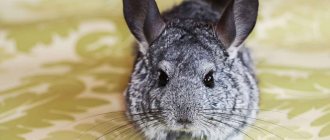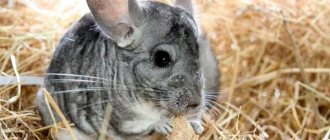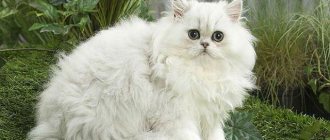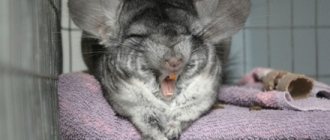Chinchillas are a genus of mammals from the chinchilla family. The chinchilla's range in the wild is limited to the highlands of South America. The valuable fur of the animals has become the reason for their intensive extermination since the appearance of European colonialists on the continent. All conservation measures taken have not helped stop the population decline. In 2008, chinchillas were classified as an “endangered species” in the International Red Book. Numerous attempts to introduce the genus in Mexico and some Asian countries, as well as to populate the natural habitat with animals bred in captivity, have not yielded positive results.
At the beginning of the last century, the first attempt was made to adapt a rodent to life in captivity. Today, chinchilla farms can be found all over the world, and some of them are engaged not only in breeding, but also in breeding work. Animals are also very popular as pets.
From whom did they come?
The prehistoric ancestors of chinchillas are considered to be animals called Meegamys by scientists. Their fossilized remains were found during excavations in the habitats of modern rodents. The age of the finds is about 40 thousand years. The biological structure of Meegamys is similar to chinchillas, but their size is much larger.
Based on the results of the excavations, a hypothesis was built that explains not only the origin of chinchillas, but also the unique properties of the animal’s fur. According to the researchers, during the process of evolution there was a gradual decrease in the size of individuals, but the number of hair follicles remained the same. As a result of these changes, the hair follicles on the skin of chinchillas are much denser than in other animals.
The closest relatives of chinchillas are porcupines, and the closest relatives in biological structure are considered to be viscacha, a genus from the chinchilla family.
Description of the animal
Chinchillas are school animals. They form groups, the number of which can reach several dozen individuals. Each colony has an individual, usually a female, who monitors the habitat of the flock and gives a signal in case of danger.
Rodents are nocturnal. They have well-developed hearing and vision; orientation in the dark is also provided by vibrissae; their length can reach 10 cm.
The sounds that chinchillas make depend on the condition of the animal:
- to communicate with other individuals or attract attention, animals make sounds reminiscent of cooing or grumbling;
- short and smooth sounds are a call for mating;
- if a rodent gets angry or shows dissatisfaction, it grinds its teeth;
- a sharp and short squeak is a sign of fear or approaching danger.
Due to the small number of chinchillas in nature and their nocturnal lifestyle, most information about the rodent was obtained based on observations of individuals kept in captivity.
What sounds does a chinchilla make?
What does it look like
The appearance of a chinchilla has the following features:
- the body and head are rounded and slightly elongated, the neck is short;
- the ears are round, there are membranes inside the auricles that cover the hearing aid while taking sand baths;
- the front legs have four grasping fingers, the hind legs are longer, thanks to which the animal is able to jump far and develop high speed;
- There are 20 teeth in the oral cavity, 4 of which are incisors; they grow throughout life and need constant grinding.
The average size of an adult chinchilla is in the range of 22-30 cm, and its weight is 700-800 g. Tail length is from 70 to 17 cm. The largest chinchilla can reach sizes of 35-38 cm and weight up to 1 kg.
How to distinguish a female from a male
Sexual dimorphism in chinchillas is practically not expressed in appearance: individuals of both sexes have the same size and color and differ slightly in size (females are larger). The only difference that makes it possible to accurately determine gender is the structure of the genital organs.
To determine the sex of the animal, you need to pick it up, lift its tail and estimate the distance between the anus and the protruding tip. In the female they are located nearby, and in the male they are located at a short distance.
Chinchilla fur
The special properties of the rodent's coat are provided by the unusual structure of the hair follicles, each of which contains from 60 to 80 villi, while the guard hairs found in other animals are completely absent.
Thanks to such dense fur, chinchillas are able to live in cold mountain climates, where temperatures drop to -30 degrees. Due to the high density of villi, they do not have ectoparasites.
Since this type of rodent lacks sebaceous and sweat glands, their fur is not protected from moisture. To dry the coat and remove dead hairs and dirt, the chinchilla bathes in fine dust or sand.
In terms of softness and density of fur, the chinchilla surpasses all wild mammals. Animal skins were used to make clothing items by the ancient Indians. At the same time, chinchilla fur was considered a luxury, available only to leaders and other titled members of the tribes, and the capture of animals was limited.
With the advent of Spanish settlers in South America, mass trapping of rodents began in order to obtain skins for export to Europe. Commercial hunting has become so widespread that a new profession has emerged in Chile: “chinchillero” (chinchilla hunter).
It is impossible to establish exactly how many animals were exterminated before the complete ban on hunting in 1929. According to surviving data on legal exports, more than 7 million chinchilla skins were exported to Europe from 1840 to 1916 alone.
Among the most expensive furs in the world, chinchilla ranks fourth.
COMMON BEAVER
Weight of chinchilla cubs from birth to one month and development table from baby to adult
Newborn animals weigh only 30 to 50 grams. Its mass depends on several factors:
- number of newborns in the litter;
- genetic predisposition;
- How did the female’s pregnancy process go?
In some cases, a newborn animal can weigh 70 grams. But this is not an indicator that it will grow into a healthy and large animal; with age, the weight can normalize and be within normal limits.
Table of body weight gain by day in the first month of life of newborns
Newborn animals can lose about two grams of body weight on the first day - this is considered normal. Already on the second day, the mass will begin to gradually increase. Every day during the first week the cub should gain an average of about two grams. In the second week, everything should grow by two to three grams every day, which will continue for another two weeks. Subsequently, the baby should gain three to four grams per day. This is presented more clearly in the table.
| day of life | Weight in grams |
| 1 | 30-50 |
| 2 | 32-51 |
| 3 | 33-54 |
| 4 | 34-56 |
| 5 | 36-59 |
| 6 | 38-61 |
| 7 | 40-63 |
| 8 | 42-66 |
| 9 | 45-69 |
| 10 | 47-72 |
| 11 | 50-75 |
| 12 | 52-77 |
| 13 | 55-80 |
| 14 | 58-83 |
| 15 | 61-86 |
| 16 | 63-89 |
| 17 | 66-92 |
| 18 | 68-95 |
| 19 | 71-98 |
| 20 | 73-101 |
| 21 | 76-104 |
| 22 | 78-107 |
| 23 | 80-110 |
| 24 | 83-113 |
| 25 | 87-117 |
| 26 | 90-121 |
| 27 | 93-125 |
| 28 | 96-129 |
| 29 | 100-133 |
| 30 | 103-137 |
Good weight gain indicates that the mother has enough milk for the baby, and poor weight gain indicates that the baby does not have enough milk. In this case, you can place the babies with a nurse. If this is not possible, you have to switch to artificial feeding. With this feeding, it is necessary to feed the babies a special mixture every two to three hours in the first week.
One month after birth, weight will increase
Table of chinchilla height and weight by month
After a month, the weight of your pets will increase, and you can find out exactly how by studying the following table:
| Age in months | Weight in grams |
| 1 | 86-137 |
| 2 | 200-242 |
| 3 | 280-327 |
| 4 | 335-385 |
| 5 | 375-435 |
| 6 | 415-475 |
| 7 | 422-493 |
| 8 | 426-506 |
| 9 | 438-528 |
| 10 | 500-600 |
This is an approximate table and therefore your pet's weight may differ slightly from the suggested values due to proper care and a balanced diet.
Types of chinchillas
The genus is represented by only two species.
Long-tailed
The full name of the species is the small long-tailed coastal chinchilla. Individuals have a long tail, and their ears are also slightly longer than those of short-tailed chinchillas.
It was this species that was domesticated and is used for breeding to this day. After rodent hunting was banned, long-tailed chinchillas were captured for some time to improve the genetic diversity of captive rodents.
Short-tailed
The species is also known as the royal chinchilla. A distinctive feature of individuals is a shorter tail and a large body. Representatives of the species have a hump on their nose, which allows them to breathe cold mountain air and settle at an altitude of up to 3 thousand meters above sea level.
The fur of short-tailed chinchillas is thicker and is more valuable. Until 1960, the species was considered extinct, but after that several scattered small colonies were identified, and the species was classified as endangered.
How big are the puppies?
Their weight range is from 25 to 60 grams. This criterion depends on the nutrition of the mother who feeds them with her milk, the conditions in which newborns are kept and the genetic characteristics of the female. A larger female gives birth to larger offspring. If, for example, mother and daughter have the same color, then with a high degree of probability we can expect that the daughter will grow up to be large.
Mature puppies need a lot of fiber to grow and achieve a normal weight; their diet should consist mainly of grass hay and food with a high protein content (25%).
Where do they live?
The historical homeland of the chinchilla is South America. Colonies of animals lived almost along the entire western coast. During the period of active trapping of fur-bearing animals, hunters burned vegetation to get to their burrows and shelters. A significant decrease in the number of animals, as well as the destruction of some plant species, reduced the habitat of the genus.
Currently, chinchillas are found only in central Chile, where the Chinchilla National Reserve was created in 1983 to preserve them.
Where do chinchillas live?
The usual habitat is mountainous terrain with little vegetation. Animals make shelters for themselves between stones, in crevices, caves; if necessary, they can dig a hole or make a home in the abandoned holes of other animals.
Reproduction
Chinchillas reach sexual maturity at the age of 6-9 months, with females maturing earlier than males. Despite the fact that rodents live in colonies, mating occurs with one permanent partner.
The first rut begins in the spring. The gestation period lasts a little more than 3 months. During this time, the female noticeably gains weight, and just before giving birth, she practically stops moving. 2-3 cubs are born in one litter. The animals are born sighted, they have teeth and are covered with fur. The female feeds the babies with milk for up to two months, but already on the 2-3rd day they begin to try plant foods.
Females give birth 2-3 times a year. Re-coating by the male occurs almost immediately after birth. Despite the ability of chinchillas to produce offspring several times per season, reproduction of the species does not occur as intensively as in other rodents due to the small number of litters.
Animals reproduce well in captivity. Thanks to many years of breeding work, it was possible to obtain many varieties with different fur colors. Today on chinchilla farms you can find individuals with a standard gray color, as well as beige, silver, white, black, brown, and purple. The rarer and more difficult the color mutation to obtain, the higher the price of the chinchilla.
How to achieve uniform development and growth of your pet?
Any owner is concerned with the question of what needs to be done and how to ensure that their little animal grows up healthy. To do this, you need to understand a few rules:
- You should handle the animal very carefully, because stressful situations can cause it to shed.
- It is necessary to maintain a suitable temperature (which is 18 degrees Celsius) and not exceed 28 degrees, otherwise the animal may die due to heat stroke.
- You need to feed the rodent once a day, with a tablespoon of chinchilla food. To maintain healthy teeth, you can give him a special mineral supplement, as well as a birch or apple tree twig.
- The cage should be metal, 50 by 50 centimeters in size and located in a cool place without direct sunlight.
- A chinchilla in a cage will need: a drinking bowl with water, wheels or ladders, a house and special sand for bathing.
If you follow these rules, there will be no problems with this rodent.
The animal should have access to: a drinking bowl with fresh water, wheels and ladders for games, a shelter for sleeping, as well as special sand for bathing..
If the conditions of detention are met, there will be no problems with this unpretentious creature.
Natural enemies
In their natural habitat, rodents become food for foxes, snakes, and large birds of prey. Protection from enemies is the camouflage coloring of the fur, good reaction and coordination, and speed of movement. Hiding from persecution, chinchillas hide in crevices and voids. The structural features of the skeleton enable the animal to penetrate narrow openings and crevices. Another unique feature of the chinchilla is that it can literally shoot out tufts of fur, discarding it in the place where the predator has grabbed hold.
A LION
Interesting Facts
- Chinchillas are perhaps the only animals whose life expectancy in captivity is shorter than in their natural habitat.
- To ensure that pets are properly cared for and fed, pet owners usually try to match the animal's life stages to the human life stages. There is no single formula that will determine the age of a chinchilla by human standards. It is generally accepted that the age of 1 month in rodents corresponds to 6 months in humans, 6 months - 14-16 years, 10-12 years - 40-45 years, and 20 years - 75 years.
- The beauty of chinchilla fur prompted breeders to develop new species of other animals with similar fur. This is how the breed of chinchilla rabbits and British chinchilla cats appeared.
- Chinchillas do not shed in the usual sense of the word. A complete change of coat occurs once in young individuals; subsequently, the coat is renewed daily by the loss of some of the old hairs.
Feeding
Chinchillas are herbivores. Due to their activity, they require a lot of protein and carbohydrates. The animals are whimsical about changing their diet. If she doesn’t like the food, she may refuse it altogether. You can also get tired of old food.
Prohibited products:
- Fried nuts, grains, seeds. You can only feed raw food.
- Cookies and flour products. Occasionally you are allowed to enjoy a wheat cracker.
- Rye. It is quite difficult for the animal to digest it.
- Food that lacks vitamins is not healthy.
- Monotonous diet.
- Food that a person eats.
High quality grain crops are used for feeding. You can pamper your pet (several times a week):
- Raisins.
- Rosehip.
- Prunes.
- Dried apples, pears, cherries and apricots.
- Hawthorn.
Suitable vegetables include carrots, cabbage, potatoes, beets (give a little no more than 2 times every 7 days). All types of nuts are acceptable except pine nuts. They impair digestion. Chinchillas will happily taste fresh melon, apple and banana.
The basis of the diet is greens (slightly dried) and hay. You cannot overfeed the animal, it will gain weight and become less mobile.











